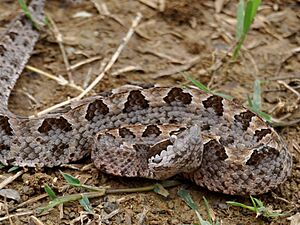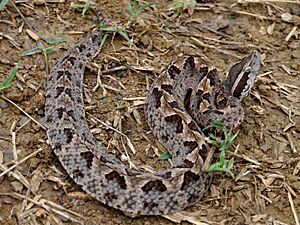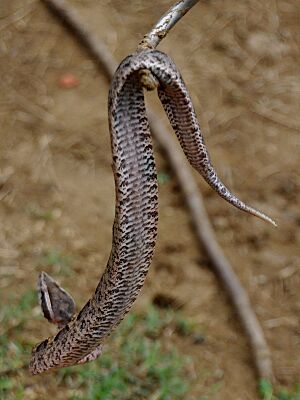Calloselasma facts for kids
The Malayan pit viper, also known as Calloselasma rhodostoma, is a type of venomous snake. It's a pit viper, which means it has special heat-sensing pits on its head. This snake is found only in Southeast Asia, including countries like Thailand, Malaysia, and the island of Java. It's the only species in its group, or "genus."
Quick facts for kids Calloselasma |
|
|---|---|
 |
|
| Conservation status | |
| Scientific classification | |
| Genus: |
Calloselasma
|
| Species: |
rhodostoma
|
| Synonyms | |
|
|
Common names for this snake include the Malayan ground pit viper, Malayan pit viper, Malayan ground snake, and Malayan moccasin.
Contents
What Does the Malayan Pit Viper Look Like?
These snakes usually grow to about 76 cm (30 in) long. Female snakes are often a bit longer than males. Sometimes, they can even reach up to 91 cm (36 in) in length. For example, a snake that is 81 cm (32 in) long might have a tail that is 9 cm (3.5 in) long.
Their bodies can be reddish, grayish, or light brown. They have two rows of large, dark brown, triangle-shaped spots with black edges. These spots can be side-by-side or alternate. Some snakes also have a thin, dark brown line down their back.
The upper part of their mouth is usually pink or yellowish with brown speckles. A wide, dark brown stripe runs from their eye to the corner of their mouth, with a lighter stripe above it. Their belly is yellowish, sometimes with gray-brown spots.
The skin on their back is smooth and arranged in 21 rows around the middle of their body. They have a pointed, slightly upturned snout. This snake is special because it's the only Asian pit viper with large scales on its head and smooth scales on its body.
Where Do Malayan Pit Vipers Live?
You can find the Malayan pit viper in several countries in Southeast Asia. These include Nepal, Thailand, Cambodia, Laos, Vietnam, and northern West Malaysia. They also live on the Indonesian island of Java. There are also reports, though not fully confirmed, of them living in southern Myanmar, northern Sumatra, and northern Borneo.
What is Their Home and Food Like?
These snakes prefer to live in coastal forests and areas with thick bamboo. They also like old, unused farmland, fruit orchards, and plantations. You might find them in forests near these plantations too. In these places, they hunt for small animals like rats and mice to eat.
How Do Malayan Pit Vipers Reproduce?
Malayan pit vipers lay eggs. After the female snake lays her eggs, she stays with them to protect them until they hatch.
Understanding Malayan Pit Viper Venom
This snake is known for being easily annoyed and quick to strike. In northern Malaysia, it causes about 700 snakebite incidents each year. While serious, only about 2 out of every 100 bites are deadly. These snakes are quite still, so they are often found in the same spot hours after someone has been bitten.
Their venom causes strong pain and swelling where the bite happened. Sometimes, it can also damage the body's tissues. Deaths are not common, but some people might have lasting problems with their limbs if they don't get treatment quickly.
A study in Thailand looked at 225 Malayan pit viper bites. Most people had mild to moderate symptoms. However, about 18% of patients ended up with limbs that stayed swollen for a long time. There were only two deaths in this study, both from bleeding in the brain. No one needed an amputation. The antivenom made in Thailand seemed to help stop blood clotting caused by the venom. Most patients did not even need antivenom. The study suggested that people should avoid traditional healers and not use tight bandages (tourniquets) too much. Bites happened all year, but mostly in May and June, at the start of the rainy season.
Venom's Use in Medicine
Scientists use the venom from the Malayan pit viper to get a special enzyme called ancrod. This enzyme is used in medicine to help break down and dissolve blood clots in patients. It can also make blood less thick. This helps to prevent serious problems like heart attacks and strokes.




